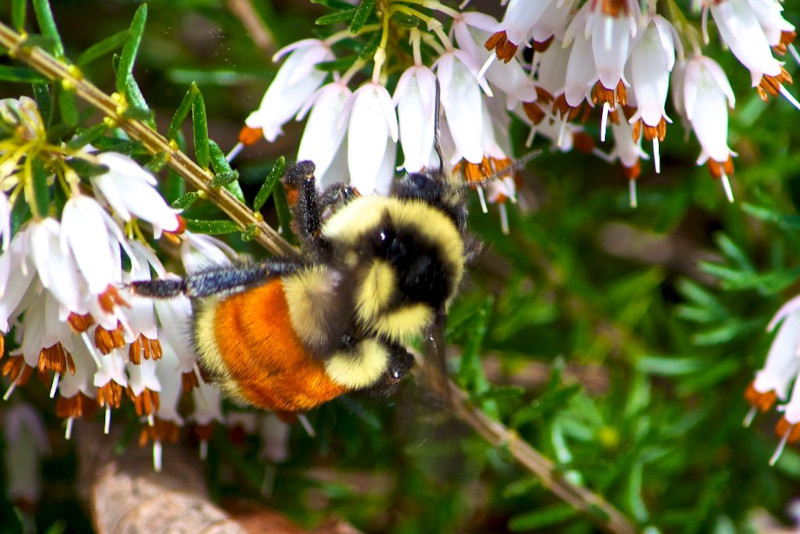
CCL: https://tinyurl.com/2s4apsss
Orange-belted Bumblebee Facts
- This vibrant creation of Nature and evolution most frequently goes by the appropriate common name of the Orange-belted Bumblebee. Yet, the natural wonder does have at least one other widely accepted general title. That’s the term of tricolored bumblebee.
- Inside of the scientific community, however, it’s perhaps somewhat better known by its technical appellation. Fortunately for the layperson, though, that’s a comparatively simple tag, as such things go. That’s because it holds the official epithet Bombus ternarius.
- The marvelous Arthropod received that moniker due to the efforts of Thomas Say. The widely respected American entomologist accomplished the first recognition of it as a separate and distinct species. He managed that scientifically noteworthy feat in the year 1837.
- Pleasantly, the amazing Orange-belted Bumblebee seems to still possess a stable and sufficient population base. That fortunate situation also appears to hold true throughout the entirety of its range. The IUCN thus currently lists it as Least Concern on its published Red List.
- The insect nevertheless faces the same potential threats to its continued existence as all species on earth now do. Most of those dangers stem from the actions of mankind. These perils include such perils as habitat loss and the ongoing effects of climate change.
Related Articles
CCL: https://tinyurl.com/2s4apsss
Orange-belted Bumblebee Physical Description
The remarkable Orange-belted Bumblebee typically draws much appreciation from those individuals who appreciate Nature. As a general principle, however, the invertebrate does not do so due to its size. That’s true since the creature ranks as a fairly small member of its Genus.
Like related species around the globe, this animal displays a certain degree of the physiological characteristic known as sexual dimorphism. In keeping with the pattern prevalent among members of its Family, though, the species manifests this trait in a different way than most others.
It’s still true that the two genders display varying physical characteristics. But, given that it’s an Apidae, it also possesses what might be considered a sub-class, as well, depending on perspective. The different groups display a range of physical characteristics that serve to distinguish them.
The queen, of course, is female. She ranges in average length from 0.67 – 0.75 in (1.7 – 1.9 cm). Her body width attains a mean measurement of approximately 0.33 – 0.35 in (0.85 -0.9 cm). Given these dimensions, it’s apparent that she developed as slightly slimmer than most of her relatives.
Males of the species, though, known as drones, achieve much smaller measurements. The shorter bodies reach an average length equaling approximately 0.37 – 0.51 in (0.95 – 1.3 cm). In terms of width, at the abdomen this sex manages a mean of between 0.18 – 0.22 in (0.45 – 0.55 cm).
Then, the species additionally has a worker class. Though technically female, they differ from the queen in tht they’re sterile. They’re also smaller than either the queen or the drones. Each only measures about 0.31 – 0.51 in (0.8 – 1.3 cm) in length. In breadth, they’re the same as males.
Differences also manifest in appearance among the various groups of the Orange-belted Bumblebee. Queens and worker show a black head, with light yellow hairs. These also present bands of yellow, orange, and black on the bodies. That trait serves as the source of the common name.
The drones, however, show a distinctlly different pattern of coloring. Its head develops as yellow in color, with a scattering of small black hairs. The pattern of hues on the body is similar, but not identical to, that of the others. This group also develops much longer fur than that of the others.
- Kingdom: Animalia
- Phylum: Arthropoda
- Class: Insecta
- Order: Hymenoptera
- Family: Apidae
- Genus: Bombus
- Species: B. ternarius
CCL: https://tinyurl.com/2s4apsss
Orange-belted Bumblebee Distribution, Habitat, and Ecology
The Orange-belted Bumblebee evolved as native to a relatively large expanse of the surface of the earth. The exact location of that zone of habitation rarely comes as a surprise to those who learn of it, however. That’s true since the natural marvel developed as endemic to North America.
Within that greater area of habitation, though, the Arthropod only appears in parts of the overall range. To the north, it inhabits much of the country of Canada. The southern section of its habitation range includes much of the northern and northeastern parts of the United States.
Just like most of its many relations, the intriguing Arthropod evolved fairly clear preferences regarding its choice of habitat. It strongly prefers the more temperate conditions found in the northern extent of its territory. On occasion, though, some do venture further south.
Yet, it does show some moderate flexibilty pertaining to what types of local ecosystems it lives in. The amazing insect prefers to make its nests in undisturbed areas, such as forests, fields, and meadows. It’s not unknown, however, for these to appear in parks or even private yards.
The Orange-belted Bumblebee further developed as a species with only a single lifecycle per season. Queens generally emerge from hibernation in late April. These constructs their nests in shallow cavities on the ground, an dlays her eggs. Its colonies rarely exceed 200 individuals.
The lovely invertebrate follows the same pattern as its numerous kindred regarding its diet. This consists solely of the nectar and pollen of various locally available plants. It does show a small preference, though. Its favorite sources include goldenrod, milkweed, and many berries.
Species Sharing Its Range
Check out our other articles on 4 Magical European Moths, Eastern Gray Squirrel, Great Barrier Reef, Indian Vulture, Appalachian Avens, Spinetail mobula, Mountain Apollo, Saltwater Crocodile
